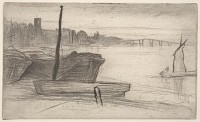Chelsea Bridge and Church | ||
| Number: | 102 | |
| Date: | 1871 | |
| Medium: | etching and drypoint | |
| Size: | 103 x 170 mm | |
| Signed: | no | |
| Inscribed: | no | |
| Set/Publication: | 'Thames Set', 1871 | |
| No. of States: | 7 | |
| Known impressions: | 56 | |
| Catalogues: | K.95; M.96; T.53; W.85 | |
| Impressions taken from this plate (56) | ||
TECHNIQUE
The main composition was etched but considerable work in dypoint was used to create more atmospheric effects. Whistler changed the composition radically, removing a barge at right after a couple of early proofs. He then drew an alternative composition with a tree in the right foreground ( ). This was not etched, and instead a sailing barge in the middle distance was substituted.
). This was not etched, and instead a sailing barge in the middle distance was substituted.
 ). This was not etched, and instead a sailing barge in the middle distance was substituted.
). This was not etched, and instead a sailing barge in the middle distance was substituted. The original delicate drypoint was strengthened in later states, occasionally resulting in some very uneven richness in the lines, but eventually it wore down and the lines have an indecisive, soft and speckled appearance. This may be why Wedmore referred to it as a 'not perfectly satisfactory dry-point'. 13 Some impressions were printed with plate tone to compensate for the fading drypoint ( ,
,  ). In some cases the drypoint lines are almost concealed by the surface ink tone on the boats and Thames banks, while the water and sky was rubbed bare, suggesting the glow of light on water (
). In some cases the drypoint lines are almost concealed by the surface ink tone on the boats and Thames banks, while the water and sky was rubbed bare, suggesting the glow of light on water ( ).
).
 ,
,  ). In some cases the drypoint lines are almost concealed by the surface ink tone on the boats and Thames banks, while the water and sky was rubbed bare, suggesting the glow of light on water (
). In some cases the drypoint lines are almost concealed by the surface ink tone on the boats and Thames banks, while the water and sky was rubbed bare, suggesting the glow of light on water ( ).
).13: Wedmore 1886 A (cat. no. 85).
The cancelled impressions, printed without burr, show clearly the patches of shading, some vertical, some horizontal, some diagonal, used like patchwork to build up the flat-looking masses of the waterfront, and boats, as well as the very fine wavy drypoint lines across the sky. It was clearly a difficult plate to print.
PRINTING
Several were printed on DEDB (DE ERVEN DE BLAUW) and/or beehive watermarked laid paper, including a fifth state ( ) and several impressions of the sixth state, as first published in the 'Thames Set' (
) and several impressions of the sixth state, as first published in the 'Thames Set' ( ,
,  ). The main print-run for the 'Thames Set', in the seventh state, both before and after the steel facing was removed, was in black ink on laid paper (
). The main print-run for the 'Thames Set', in the seventh state, both before and after the steel facing was removed, was in black ink on laid paper ( ,
,
 ), several with watermarks, including 'DE ERVEN DE BLAUW' (
), several with watermarks, including 'DE ERVEN DE BLAUW' ( ,
,  ), and 'KF' (
), and 'KF' ( ). One sheet has distinct indents along one edge, showing that it came from a book or ledger (
). One sheet has distinct indents along one edge, showing that it came from a book or ledger ( ). Usually the paper was not trimmed or signed, though one impression of the final state was returned to Whistler for signing, probably in the 1890s (
). Usually the paper was not trimmed or signed, though one impression of the final state was returned to Whistler for signing, probably in the 1890s ( ). A cancelled impression on laid paper is unusual in having a Strasbourg lily watermark (
). A cancelled impression on laid paper is unusual in having a Strasbourg lily watermark ( ).
).
 ) and several impressions of the sixth state, as first published in the 'Thames Set' (
) and several impressions of the sixth state, as first published in the 'Thames Set' ( ,
,  ). The main print-run for the 'Thames Set', in the seventh state, both before and after the steel facing was removed, was in black ink on laid paper (
). The main print-run for the 'Thames Set', in the seventh state, both before and after the steel facing was removed, was in black ink on laid paper ( ,
,
 ), several with watermarks, including 'DE ERVEN DE BLAUW' (
), several with watermarks, including 'DE ERVEN DE BLAUW' ( ,
,  ), and 'KF' (
), and 'KF' ( ). One sheet has distinct indents along one edge, showing that it came from a book or ledger (
). One sheet has distinct indents along one edge, showing that it came from a book or ledger ( ). Usually the paper was not trimmed or signed, though one impression of the final state was returned to Whistler for signing, probably in the 1890s (
). Usually the paper was not trimmed or signed, though one impression of the final state was returned to Whistler for signing, probably in the 1890s ( ). A cancelled impression on laid paper is unusual in having a Strasbourg lily watermark (
). A cancelled impression on laid paper is unusual in having a Strasbourg lily watermark ( ).
).
